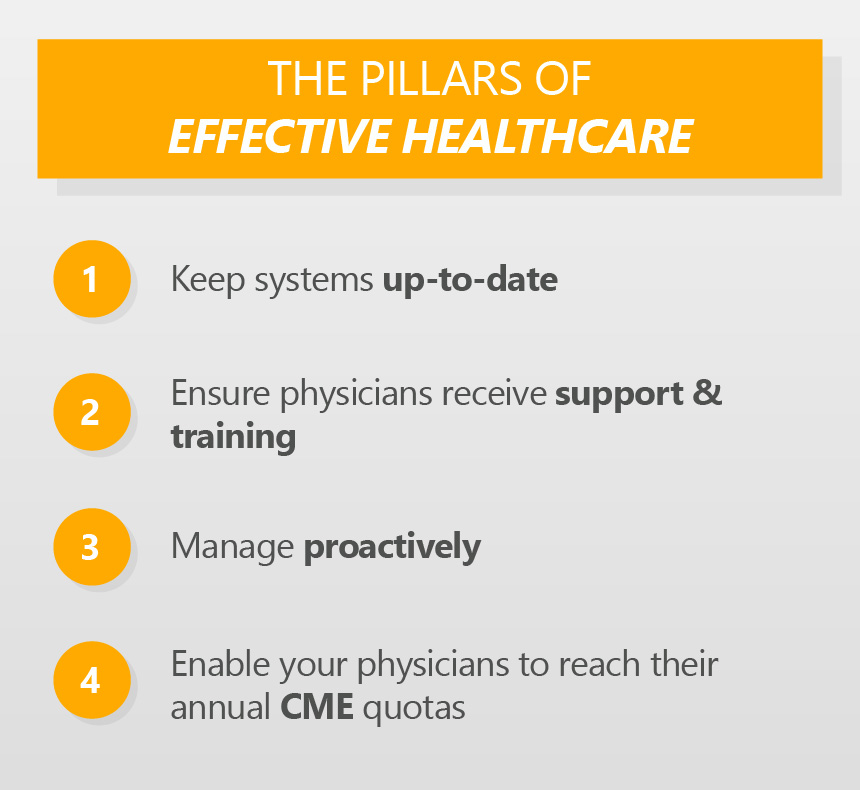Providing Effective Healthcare: Steps You Can Take
The goal of any healthcare facility is providing effective healthcare. Effective healthcare can only be achieved through efficiency and patient experience. Efficiency and patient experience often go hand-in-hand – spending less time on documentation and other administrative tasks can mean more time for patient care.
On the flip side, patients want to feel cared for; not rushed. Efficiency should never get in the way of providing good care.
The pillars of effective healthcare are training, up-to-date systems, continuing medical education, and proactive management. In this article, we’ll explore what effective healthcare looks like and how to stay on top of these pillars in your organization.
What is effective care in healthcare?
Outside of the main pillars of effective healthcare, timeliness, satisfied patients, and availability are characteristics of effective care in health and social care. Among the most popular hospital effectiveness measurement tools is the Healthcare Effectiveness Data and Information Set (HEDIS), which measures on more than 90 performance indicators.
By determining how your healthcare facility is performing with tools like HEDIS, you’ll gain more accurate, actionable insights on improving healthcare. You can use these insights to guide purchasing decisions or find areas where your healthcare facility is underperforming.
Effective care is safe, accessible, and efficient – but most of all, a good patient experience. Safety and clinical effectiveness are so important because they contribute to patient health and satisfaction. Taking steps to improve patient experience leads to more patients and increased profitability.
What are the key factors to providing effective health care?
Keeping Systems Up-To-Date
The first factor in providing effective healthcare is keeping systems up-to-date. This means updating your current systems, keeping an eye out for systems that improve upon your current capabilities, and researching the systems used by industry leaders.
Keeping up with technology is important in healthcare. Even if you aren’t considering upgrading your systems or introducing new tools, knowing what’s out there can give you a leg up.
To get an idea of where you should consider investing in upgrades or new tools, pinpoint the areas that are taking the most time. Maybe that’s addressing phone calls, logging patient visits in the EHR, or really anything that might slow down your team and take longer than it should. Your team knows best where they feel they’re spending too much time – rely on their input to guide you towards problem areas.
Once you’ve determined the areas that are taking too much time, it’s time to dig a bit further. If you find that the EHR is taking too much time, is it because the EHR itself is slow? Difficult to navigate? Or is it because users are manually entering information?
Any of these could be the problem and each with a different solution – you might consider a new EHR, training physicians in navigating the EHR, or an automated speech recognition solution.
Start with the problem, then find the root cause and address it.
Searching for speech recognition software?
Start recording your dictations accurately with our easy-to-use platform, Fusion Narrate.
Proper training + support for systems
Keeping systems up-to-date is only half the battle – it’s also vital to keep physicians trained on current and new systems. The tools are only valuable once everyone on your team has the knowledge of not only how to use them, but to use them effectively.
All software installs will have some sort of training, whether that’s self-guided through documentation and/or a help center or virtual and in-person training with a dedicated trainer.
Much like software without training, software without support can be much less effective. Often, bugs or unique scenarios will pop up that require guidance or expertise from the software vendor. When making purchasing decisions, keep an eye out for what other users have to say about a vendor’s support.
Proactive management
Determine what might impact your efficiency, and what is currently impacting your efficiency. Part of this falls in line with keeping systems up-to-date, but it’s also about having an open dialogue with healthcare personnel. If they are unhappy or feel like something isn’t being addressed properly, take that feedback and see what you can do to make it right. Even resolving isolated incidents can improve physician satisfaction, which in turn improves patient satisfaction and healthcare effectiveness.
Continuing Medical Education
Beyond training on existing and new systems, it’s important to provide continuing medical education (CME) opportunities for healthcare personnel. This allows for personal and professional development within your team, and is an investment that always adds value back to your facility and your physicians.
Offering an allowance to aid physicians meeting their CME licensure requirements can be an excellent indication of your support for their education and allow physicians to attend the courses they are most interested in, which can again raise physician satisfaction and keep your team educated and effective.
Higher efficiency, which can be attained through the other 3 pillars of effective healthcare, can also allow physicians more time to complete their required CME.

How can healthcare efficiency be improved?
The first step to improving efficiency is setting a benchmark for your current efficiency to compare against. Using a performance indicator tool like HEDIS can be a great first step in determining efficiency and areas that need to be improved. You can also do some of this work internally by interviewing or monitoring healthcare personnel to pinpoint repetitive work.
In both cases, once you’ve found your starting point, the next step is to determine what work can be automated or at least made more efficient. Then, research which tools are best suited for the job – either tools that are already used within the facility or entirely new tools.
Selecting new tools can be a long, arduous process that requires thorough research, but this can be aided by once again relying on your team for recommendations or suggestions to get a sense of what’s out there.
Focusing on these key factors – systems, training, management, and CME – is what makes a health system effective. Everyone on the team must be willing to continually improve and learn to meet the evolving standard for healthcare efficiency. You’ll need to prioritize education, efficiency, and patient experience to meet that standard.
